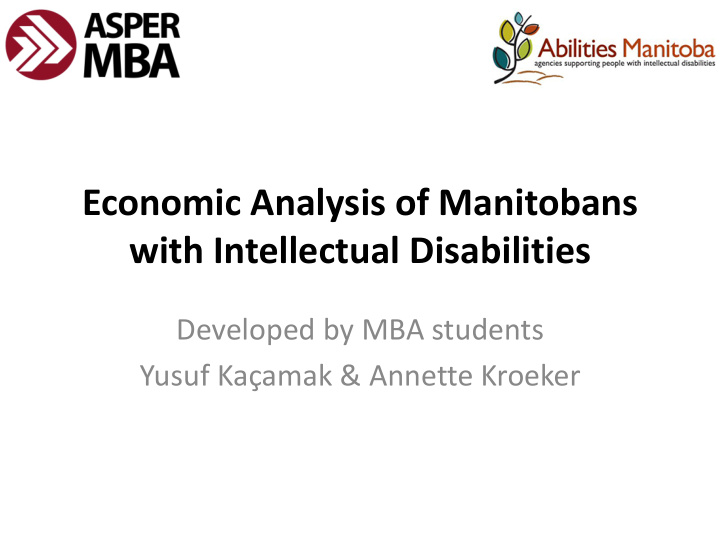



Economic Analysis of Manitobans with Intellectual Disabilities Developed by MBA students Yusuf Kaçamak & Annette Kroeker
Agenda 1. Problem Definition 2. Observations 3. Recommendations 4. Method 5. Overview of Findings 6. Key Findings 7. Tactics & Implementation 8. Q&A
Problem Definition Persons with intellectual disabilities are members of the workforce, • volunteer in the community, pay taxes and make positive contributions to the Manitoba economy. In the context of a provincial government spending and program review, • Abilities Manitoba has drafted a business case to evaluate the economic “value” of persons with intellectual disabilities. The “value” of persons with intellectual disabilities to the Manitoba • economy has not been measured in a substantive way to date.
Observations • Strong economic argument for businesses and government to employ persons with intellectual disabilities • Shortage of accessible data • Data available not easily compared http://www.bigdatacompanies.com/big-data-away-from-hype-to-an-improved-bottomline/ https://www.theodysseyonline.com/compare-apples-oranges
Recommendations • Survey to collect economic and social impact data for Manitoba – Client (persons with intellectual disabilities) – Employers who hire persons with intellectual disabilities • Increase supported employment opportunities versus sheltered employment • Increase awareness in businesses
Method • Research 1 • Interview 2 • Media Sources 3 • Consultation with Government 4 • New Direction 5
Overview of Findings • Current state – Canada – Manitoba – Global • Current spending • Benefits – Individuals – Business – Government
Key Findings • Current State – Canada (IRIS) Education Levels (Crawford (IRIS), 2011) Employment Rate (Crawford (IRIS), 2011)
Key Findings • Current State – Canada (Statistics Canada) Employment Rates by Education Level and Severity of Disability (Statistics Canada, 2014)
Key Findings • Current State – Manitoba (Barrier-Free MB) – 56.4% Manitobans with disabilities employed (77.3% without disabilities) – Employment barriers – 55% of EIA clients are individuals with disabilities – Labour Market Agreement for Persons with Disabilities (LMAPD) Employment Status of Manitobans with Disabilities (Barrier-Free Manitoba, 2017)
Key Findings • Current State – Global – Supported vs sheltered employment – Unfair wages – Low average work hours – Low access to health care plans Weekly Earnings of Individuals with Developmental Disabilities (Boeltzig et al., 2008)
Key Findings Current Spending
Key Findings • Economic Benefits – Individuals – Increased independence at work – Meaningful friendships – Improved self-esteem – Better time management skills – Increased social networks – Greater sense of social status – Greater financial security Walgreens
Key Findings • Economic Benefits – Business – Increased profitability – Increased creativity, innovation, and better decision making – Higher employee retention, attendance – New customer base – Safer workplace with less incidents Istanbul, Turkey
Key Findings • Economic Benefits – Government – Increased income tax revenue – Decreased spending on financial assistance – Increased income tax revenue through families, parents, caregivers added to workforce Caritas, Egypt
Tactics & Implementation
Tactics & Implementation
Success Stories • Tim Hortons • Wendy’s Restaurants • Walgreens • Sodexo Canada Ltd. Tim Hortons
Thank you!
Recommend
More recommend